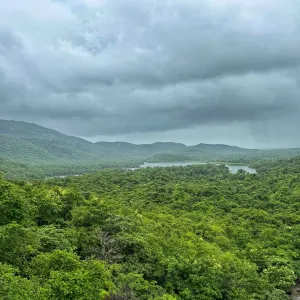Biodiversity Hotspots: Explore India’s Natural World Heritage Locations
 Deepanshu Travel
30 Jul, 2025
8 mins read
33
Deepanshu Travel
30 Jul, 2025
8 mins read
33

India is a country known for its rich variety of plants, animals, and landscapes. From tall mountains to deep forests and long coastlines, India is home to many unique natural places. Some of these areas are so important that they are recognized by UNESCO as World Heritage Sites. These are places that need to be protected for future generations. In this article, we will take a closer look at some of these amazing natural spots. Biodiversity Hotspots: Explore India’s Natural World Heritage Locations and understand why they matter.
Western Ghats
The Western Ghats is one of the oldest mountain ranges in the world. It stretches across the states of Kerala, Tamil Nadu, Karnataka, Goa, Maharashtra, and Gujarat. This area is full of green forests, flowing rivers, and rare plants and animals. Some animals found here like the lion-tailed macaque and the Malabar civet cannot be found anywhere else in the world.
This place is also very important because many rivers start here. These rivers provide water to millions of people. The forests in the Western Ghats also help in keeping the air clean and the climate balanced. Several protected areas like Silent Valley National Park and Periyar Wildlife Sanctuary are part of this region.
Kaziranga National Park
Located in the state of Assam, Kaziranga National Park is famous for the one-horned rhinoceros. This park has the highest number of these animals in the world. It also has elephants, tigers, and many kinds of birds. The tall grasslands and swamps make it a perfect place for these animals to live.
Kaziranga is also a safe place for migratory birds that travel long distances to escape the cold in other parts of the world. The park becomes a beautiful sight during winter with birds like pelicans and storks making it their temporary home.
Manas Wildlife Sanctuary
Also in Assam, Manas Wildlife Sanctuary is located at the foothills of the Himalayas. It is a mix of forest, grassland, and riverine ecosystems. The sanctuary is home to some rare and endangered animals like the golden langur and pygmy hog.
Manas is not just a wildlife area. It is also important for the local communities who live nearby. They depend on the forest for wood, medicine, and food. Conservation work in Manas includes helping people understand how to protect nature while also meeting their daily needs.
Sundarbans National Park
The Sundarbans is the largest mangrove forest in the world and is found in the state of West Bengal. It is famous for the Royal Bengal Tiger, which has adapted to swimming and hunting in the salty waters. The area is full of rivers and creeks and is also home to crocodiles, snakes, and many kinds of fish and birds.
The mangroves act as a natural barrier that protects the coastline from storms and floods. They also help in preventing soil erosion. However, rising sea levels and pollution are big threats to this fragile ecosystem.
Nanda Devi and Valley of Flowers National Parks
Located in the state of Uttarakhand, these two parks are surrounded by tall Himalayan mountains. Nanda Devi is one of the highest peaks in India. The Valley of Flowers, as the name suggests, blooms with colorful flowers during the monsoon season.
The area is not only beautiful but also rich in biodiversity. Snow leopards, Himalayan musk deer, and blue sheep live in these cold, high-altitude regions. The flowers attract butterflies and bees which play an important role in pollination.
These parks also hold religious and cultural value for local communities. Pilgrims visit this area during their spiritual journeys and consider the land sacred.
Great Himalayan National Park
This national park is in Himachal Pradesh. It includes forests, meadows, and snowy peaks. The park is home to many endangered animals such as the western tragopan, Himalayan brown bear, and snow leopard.
The Great Himalayan National Park is a good example of how wildlife and people can coexist. Local people have been living near the park for many years and depend on it for grazing animals and collecting herbs. Now, many of them are involved in eco-tourism which helps in protecting the forest while also earning income.
Why These Places Matter
Natural World Heritage Sites in India are not just tourist spots. They are living examples of how nature supports life. These places provide clean water, fresh air, and a home for many plants and animals. They also help in controlling climate change by storing carbon and regulating rainfall.
But many of these areas are under threat. Pollution, cutting of trees, climate change, and growing human population are causing damage. We need to take steps to protect them. Simple actions like reducing waste, supporting eco-friendly tourism, and spreading awareness can help.
Biodiversity Hotspots: Explore India’s Natural World Heritage Locations and Protect Nature
We often think of nature as something separate from our daily lives. But the truth is that we are all connected. If forests disappear, animals will lose their homes. If rivers dry up, we will have no water to drink. That is why protecting biodiversity is not just the job of scientists or forest officers. It is something each one of us must care about.
When we visit these places, we should act responsibly. Do not litter, avoid loud noises, and respect the rules. Support local guides and buy products made by local communities. These small steps go a long way in keeping these places safe.
Final Thoughts
India is blessed with some of the most beautiful and unique natural sites in the world. These World Heritage Sites are more than just scenic spots. They are vital for life on Earth. By understanding and respecting their value, we can make sure they stay healthy for years to come.
Let us take pride in these natural wonders and do our part in preserving them. Every small action counts when it comes to protecting nature.
Written By:
Deepanshu Travel



Hotels at your convenience
Now choose your stay according to your preference. From finding a place for your dream destination or a mere weekend getaway to business accommodations or brief stay, we have got you covered. Explore hotels as per your mood.


